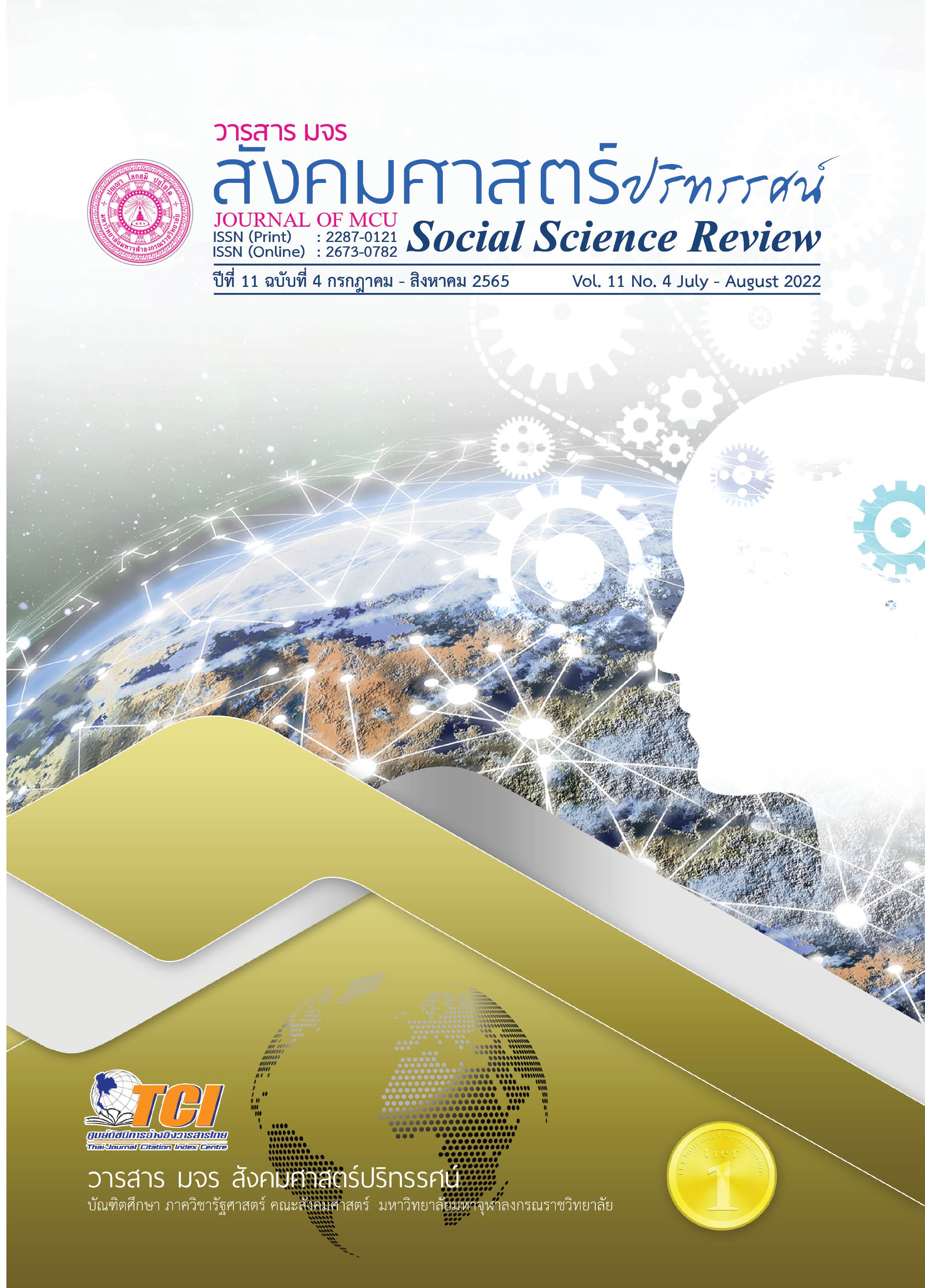โมเดลความสัมพันธ์เชิงสาเหตุการขับเคลื่อนนโยบายด้านความเท่าเทียมทางเพศของกระทรวงการพัฒนาสังคมและความมั่นคงของมนุษย์
คำสำคัญ:
การขับเคลื่อนนโยบาย, ความเท่าเทียมทางเพศ, สาราณียธรรม 6บทคัดย่อ
บทความวิจัยนี้มีวัตถุประสงค์เพื่อศึกษาความสัมพันธ์เชิงสาเหตุการขับเคลื่อนโยบายด้านความเท่าเทียมทางเพศ เป็นการวิจัยแบบผสานวิธี ข้อมูลเชิงปริมาณเก็บข้อมูลจากกลุ่มตัวอย่าง 310 คน สุ่มตัวอย่างแบบโควตา วิเคราะห์โมเดลสมการโครงสร้าง การวิจัยเชิงคุณภาพใช้วิธีการสัมภาษณ์เชิงลึกกับผู้ให้ข้อมูลสำคัญ 14 รูปหรือคน ใช้การสุ่มแบบเจาะจงและวิเคราะห์ข้อมูลโดยใช้การวิเคราะห์คำหลักกับการวิเคราะห์สารระบบ
ผลการวิจัยพบว่า โมเดลความสัมพันธ์เชิงสาเหตุการขับเคลื่อนนโยบายด้านความเท่าเทียมทางเพศ พบว่า สอดคล้องกับข้อมูลเชิงประจักษ์ โดยการเคลื่อนไหวทางสังคมมีอิทธิพล ทางตรงและอิทธิพลทางอ้อมทำให้เกิดผลการขับเคลื่อนนโยบายด้านความเท่าเทียมทางเพศ นอกจากนี้การขับเคลื่อนนโยบายด้านความเท่าเทียมทางเพศ เมื่อบูรณาการร่วมกับหลักสาราณียธรรม 6 จะส่งผลต่อการขับเคลื่อนนโยบายด้านความเท่าเทียมทางเพศ โดยพบว่าค่า p-value มีนัยสำคัญทางสถิติเท่ากับ 0.412 ค่าไค-สแควร์เท่ากับ 46.44 ค่าองศาอิสระ (df) เท่ากับ 45 ค่าสัดส่วนไค-สแควร์ ( /df) เท่ากับ 1.032 ค่าดัชนีวัดระดับความสอดคล้อง (GFI) เท่ากับ 0.99 ค่าดัชนีวัดระดับความสอดคล้องที่ปรับแก้แล้ว (AGFI) เท่ากับ 0.93 ค่าดัชนีวัดระดับความสอดคล้องเปรียบเทียบ (CFI) เท่ากับ 1.00 ค่ารากของค่าเฉลี่ยกำลังสองของความคลาดเคลื่อนมาตรฐาน (SRMR) เท่ากับ 0.032 ค่าความคลาดเคลื่อนในการประมาณค่าพารามิเตอร์ (RMSEA) เท่ากับ 0.010 อย่างมีนัยสำคัญทางสถิติที่ระดับ 0.01
เอกสารอ้างอิง
กระทรวงการพัฒนาสังคมและความมั่นคงของมนุษย์. (2562). ยุทธศาสตร์กระทรวง พ.ศ. 2560-2564. สืบค้น 17 มิถุนายน 2563, จาก http://www.m-society.go.th
กฤษณ์ รักชาติเจริญและคณะ (2560). ปัจจัยชี้วัดความสำเร็จในการขับเคลื่อนมติสมัชชาสุขภาพแห่งชาติสู่การปฏิบัติ. วารสารวิชาการมหาวิทยาลัยกรุงเทพ, 15(2), 1-16.
คณาพงษ์ พึ่งมี. (2562). ภาวะผู้นำเชิงพุทธของผู้บริหารสถาบันวิจัยวิทยาศาสตร์และเทคโนโลยีแห่งประเทศไทย. วารสารพุทธนวัตกรรมและการจัดการ, 2(2), 50-58.
ฐานิดา พานิชเจริญ. (2564). การให้บริการตามหลักพุทธธรรมของโรงพยาบาลราชบุรี. วารสารพุทธนวัตกรรมและการจัดการ, 4(2), 39-47.
บารมี พานิช และ สุพรรณี ไชยอำพร. (2559). รูปแบบและขั้นตอนการขับเคลื่อนร่างพระราชบัญญัติการจดทะเบียนคู่ชีวิตในประเทศไทย. กรุงเทพฯ: สถาบันบัณฑิตพัฒนบริหารศาสตร์.
ประกายกาวิล ศรีจินดา. (2562). กลุ่มไอดอล MUM 48 กับการขับเคลื่อนความเสมอภาคทางเพศในอินเดีย. วารสารวิชาการมหาวิทยาลัยราชภัฏกาญจนบุรี, 8(1), 6-13.
ปิยะนุช เรืองโพน และ เตชทัช คลายโศกก์. (2560). กองทุนพัฒนาบทบาทสตรี ความสำเร็จและความท้าทายในการนำนโยบายไปปฏิบัติ. วารสารศิลปศาสตร์และวิทยาการจัดการ, 4(7), 54-71.
พรรณสุภา โพธิ์ย้อย และ ณัฐกริช เปาอินทร. (2561). การนำนโยบายสภาวัฒนธรรมไปปฏิบัติ กรณีศึกษาสภาวัฒนธรรมตำบล จังหวัดสมุทรสาคร. วารสารการเมืองการปกครอง, 8(3), 132-151.
พระมหาวิเศษ กนฺตธมฺโม. (2562). การจัดการความขัดแย้งตามหลักสาราณียธรรม. วารสารสหวิทยาการนวัตกรรมปริทรรศน์, 2(1), 32-38.
ภคพล เส้นขาว. (2561). การเลือกปฏิบัติต่อสตรีข้ามเพศในสังคมไทย. วารสารรามคำแหง, 39(1), 149-168.
สิริวิมล พยัฆษี. (2560). ความไม่เท่าเทียมในสิทธิกับกลุ่มคนที่มีความหลากหลายทางเพศ. เอกสารประกอบการประชุมวิชาการ สาขาสังคมวิทยาและมานุษยวิทยา, 16, 904-914.
อารยา สุขสม. (2561). รัฐธรรมนูญไทยกับความหลากหลายทางเพศ. วารสารนิติสังคมศาสตร์, 11(2), 87-120.
Hair et al. (2010). Multivariate Data Analysis (7th ed.). New Jersy: Pearson Education.
LGBT Capital. (2019). Estimated LGBT Purchasing Power: LGBT-GDP- data as of year-end 2019, Retrieved October 20, 2020, from http://www.lgbt-capital.com/docs/Estimated_LGBT-GDP_(table)_-_2020.pdf
ดาวน์โหลด
เผยแพร่แล้ว
รูปแบบการอ้างอิง
ฉบับ
ประเภทบทความ
สัญญาอนุญาต
ลิขสิทธิ์ (c) 2022 วารสาร มจร สังคมศาสตร์ปริทรรศน์

อนุญาตภายใต้เงื่อนไข Creative Commons Attribution-NonCommercial-NoDerivatives 4.0 International License.
เพื่อให้เป็นไปตามกฎหมายลิขสิทธิ์ ผู้นิพนธ์ทุกท่านต้องลงลายมือชื่อในแบบฟอร์มใบมอบลิขสิทธิ์บทความให้แก่วารสารฯ พร้อมกับบทความต้นฉบับที่ได้แก้ไขครั้งสุดท้าย นอกจากนี้ ผู้นิพนธ์ทุกท่านต้องยืนยันว่าบทความต้นฉบับที่ส่งมาตีพิมพ์นั้น ได้ส่งมาตีพิมพ์เฉพาะในวารสาร มจร สังคมศาสตร์ปริทรรศน์ เพียงแห่งเดียวเท่านั้น หากมีการใช้ภาพหรือตารางหรือเนื้อหาอื่นๆ ของผู้นิพนธ์อื่นที่ปรากฏในสิ่งตีพิมพ์อื่นมาแล้ว ผู้นิพนธ์ต้องขออนุญาตเจ้าของลิขสิทธิ์ก่อน พร้อมทั้งแสดงหนังสือที่ได้รับการยินยอมต่อบรรณาธิการ ก่อนที่บทความจะได้รับการตีพิมพ์ หากไม่เป็นไปตามข้อกำหนดเบื้องต้น ทางวารสารจะถอดบทความของท่านออกโดยไม่มีข้อยกเว้นใดๆ ทั้งสิ้น





